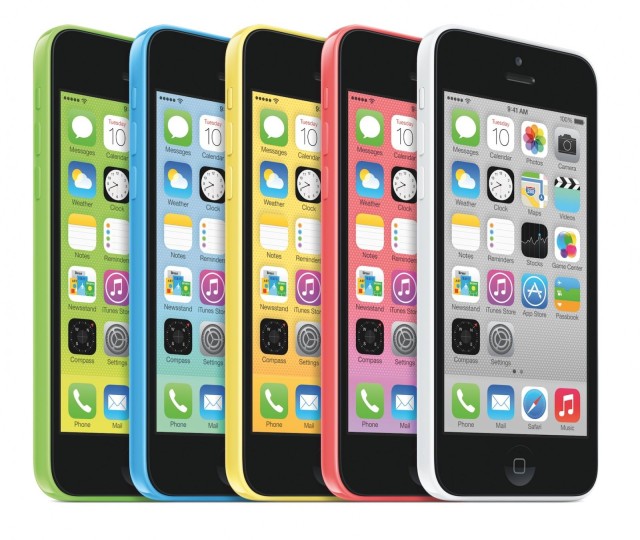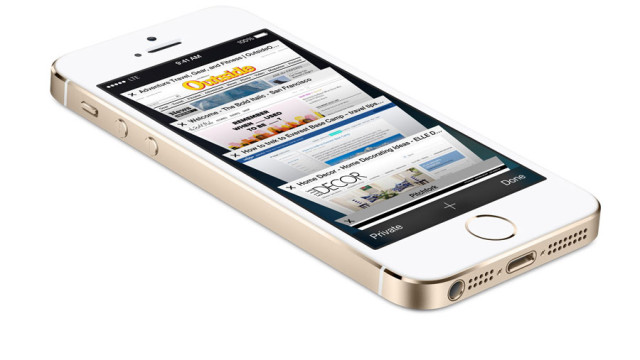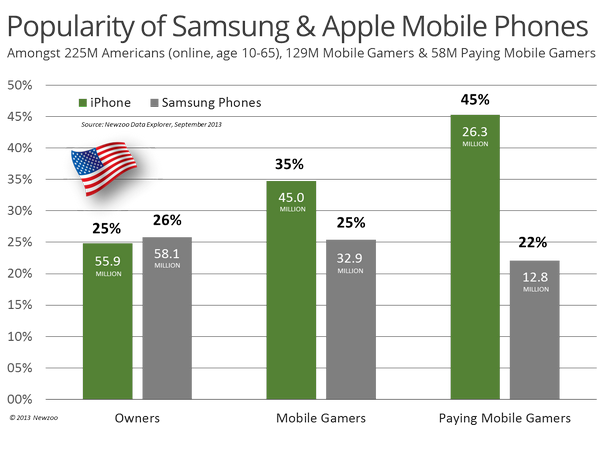Apple’s long-anticipated iPhone reveal event took place yesterday with a big surprise: There were no big surprises, since all of the key information had already been leaked. Apple introduced the iPhone 5c, which replaces the iPhone 5 at a lower price, and the iPhone 5s, the new high end of the iPhone line, available September 20, and announced that iOS 7 would be available on September 18.
The iPhone 5c essentially puts the existing iPhone 5 in a colorful plastic shell (available in 5 candy colors — green, white, blue, red, and yellow) with only minor improvements to the front camera. The A6 processor and the battery remain the same, but the price is lower: $99 for a 16GB iPhone 5c and $199 for a 32GB iPhone 5c with a two-year contract.
The new iPhone 5s (available in silver, gray and gold) features a 64-bit A7 processor, the first 64-bit processor in a smartphone. This doubles the graphics power and CPU power over the iPhone 5, and makes the iPhone 5s 40x more powerful than the original iPhone CPU (and 56x more power than the original iPhone’s graphics). The 8 MP camera features a larger sensor, larger pixels, redesigned 5 element lens and two-color LED flash to provide much better images, along with 120 fps video at 720p resolution for 4x slow-mo video. The 5s also has a fingerprint sensor built into the Home button so you can turn on the phone or purchase items with just a finger touch. The iPhone 5s is $199 for 16GB, $299 for 32GB, and $399 for 64GB.

Finally, iOS 7 is almost ready for release, available for iPhone 4 and up as well as iPad 2 and up. The software is fully rewritten in 64 bits to support the new iPhone 5s. Apple promises users that iOS 7 will now include free iWorks (for buyers of new iDevices) and iTunes Radio, along with myriad enhancements.
Reaction to the new hardware and software was generally positive. “The 5C is a high-powered, well-designed phone with a competitive spec, plus Apple branding for $99,” said Clive Downie, CEO of mobile game giant DeNA West. “That’s an attractive combination for consumers who have been aspiring the brand but can’t break in due to the price point. I wouldn’t be surprised if we see entry-level consumers opt for the 5C.”
Downie was not sure how much of an impact the 5s would have on the game industry. “It’s hard to tell until we have our hands on it,” he said. “Consumers playing games on their phones want interaction that suits their available time and an immersive experience that satisfies that time spent. As can be seen with the charts, a guide to popularity, this doesn’t always have to come with high fidelity visuals. For some consumers, higher fidelity will help. For others it’s not important.”
“It’s not quite the revolution everyone expected,” said analyst Scott Steinberg, CEO of TechSavvy Global. “The 5C should help Apple regain some of its lost ground — by lowering the price you increase the audience size exponentially. If you look at the 5s, we’re seeing some nice gains in performance and graphics power. But the reality is we’ve reached a tipping point where graphics isn’t the problem, it’s visibility. Consumers aren’t demanding premium graphics on phones.”

Chris Ulm, CEO of mobile developer Appy Entertainment, has mixed feelings about the 5c. “Getting on NTT Docomo [in Japan] is huge for Apple, while the rumored China Mobile deal (with 700 million subscribers) will be even huger,” Ulm said. “I am disappointed in the non-contract price for the 5c — at $549, it seems too expensive to be a real market share weapon in developing or for mid-priced phones but rather will solidify the iPhone’s hold on the high end of the smartphone market.”
It’s really about profit margins for Apple, more than market share, and the decision has a practical side, Ulm believes. “Personally, I would have loved to see Apple come in at least $100 lower on the 5c so they could make a serious run at entry level, middle class buyers in India, Brazil and Russia, but I think they are making trade-offs based on current demand and production capacity: Why make cheaper phones when they sell everything they are capable of making at higher margins ”
The 64-bit A7 chip in the iPhone 5s is more important for the future of Apple than it is for this particular phone, according to Ulm. “I think its a mistake to look at the A7 only as the iPhone chip and instead look at it as the flagship for future iOS devices, including AppleTV,” Ulm pointed out. “Apple has clearly been setting the groundwork for a serious run at the living room and I see the A7 (and the A series beyond) as being the workhorse chips for iPads, big screen TV’s and eventually mobile computers. The additional capability of the A7 will allow the transition to Xbox 360 level production values on mobile games as we move to always connected, multi-screen 3D-centric games.”
Analyst Peter Warman of Newzoo pointed out some important metrics regarding Apple and games in a recent post. “Despite higher growth rates, overall Google Play revenues still stand at only 47 percent of the the total generated by Apple’s iOS stores,” Warman noted. “In terms of revenues generated through content on smartphones and tablets, it is important to understand the significance of games. On a global scale, one in three downloads from any app store is a game. Moreover, two in three dollars spent on these apps is on, or rather in, games. Apple is expected to gross close to $2 billion this year solely from their 30 percent share on mobile games spending.”
The scale of the overall mobile games market is immense and growing, and Apple’s iOS is taking the lion’s share of the profits from it compared to Android. “According to Newzoo’s Global Games Market Report, worldwide spending on mobile games will grow 34 percent this year, from $9.1 billion to $12.2 billion,” said Warman. “At the end of 2013, the number of tablet and smartphone gamers will surpass one billion. By 2016, mobile games are expected to claim 28 percent of the global games market, generating almost $24 billion, representing a huge global growth opportunity.”

The battle for market share and profits in the USA between Samsung (the leading Android phone provider) and Apple illustrates how Apple is focusing on profits more than market share. “A slightly higher share of Americans aged between 10 and 65 uses a Samsung phone than an iPhone: 26 percent versus 25 percent,” said Warman. “When investigating the market share amongst 129 million mobile gamers, the share of iPhone users jumps to 35 percent and even 45 percent if we only take the 58 million American paying mobile gamers into account. Ultimately, Apple reaches twice the number of paying mobile gamers than Samsung, despite having a lower absolute number of device users.”
Apple is playing the long game here by keeping iPhone prices and margins high. The lower price of the 5c isn’t as much lower as some analysts had hoped, but it will still move massive numbers of units and help regain market share for Apple. At the same time, it will keep Apple’s profits high. This also helps developers, as Apple buyers tend to have more money and more willingness to spend money on games.
The iPhone 5s won’t make a huge impact on gaming, but it is interesting to note that the only third-party company Apple put on stage was a game company (ChAIR Entertainment). Of course, a game like Infinity Blade III shows the power of the new iPhone 5s more clearly than any productivity app. This also shows the importance that Apple now attaches to games — 240 million people signed up for Game Center shows the game market on iOS is considerable.

